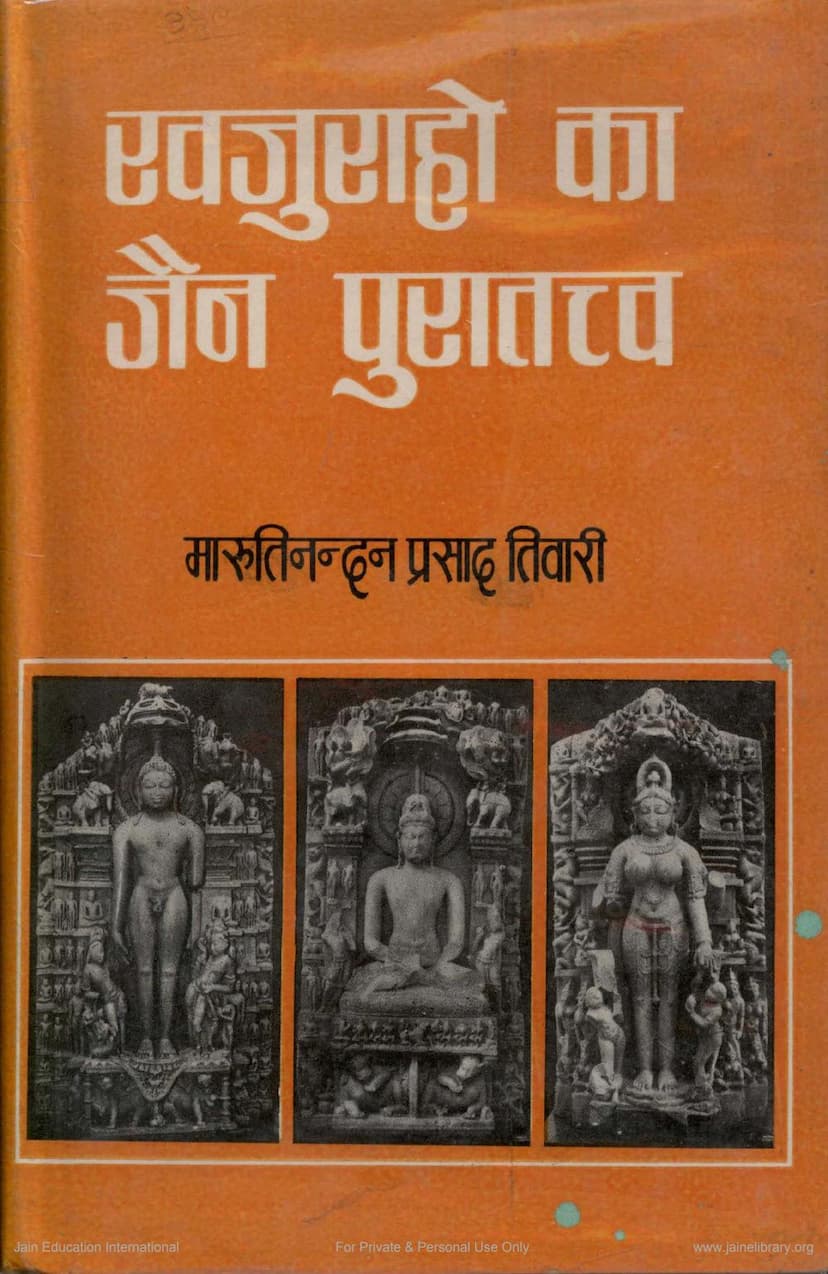Khajuraho Ka Jain Puratattva
Added to library: September 2, 2025

Summary
This document is a comprehensive study of the Jain archaeology and art of Khajuraho, authored by Dr. Maruti Nandan Prasad Tiwari and published by Sahu Shanti Prasad Jain Kala Sangrahalay, Khajuraho, in 1987. The book delves into the rich Jain heritage found at this historically significant site, which flourished between the 10th and 12th centuries CE under the Chandela rulers.
Here's a breakdown of the key aspects covered in the text:
1. Introduction and Background:
- Khajuraho is renowned for its temples and sculptures, famous for their architectural grandeur and exquisite beauty, respectively.
- While considerable research has been conducted on the Brahmanical temples and sculptures of Khajuraho, this book represents the first comprehensive study specifically dedicated to its Jain temples and sculptures.
- The author emphasizes the importance of studying major Jain art centers independently to understand the overall development of Jain art and architecture.
2. Historical and Cultural Context:
- The book places Khajuraho's Jain art within its political and cultural background during the Chandela period.
- It notes that despite Jains being a minority, they held significant influence during the Chandela era, facilitated by the rulers' religious tolerance and broad-mindedness.
- The text highlights the patronage of Jain art by wealthy Jain merchants and their active participation in religious organizations and temple construction.
3. Jain Temples of Khajuraho:
- Khajuraho was a major political and artistic center during the Chandela dynasty, with numerous temples dedicated to Shaivite, Vaishnavite, Shakta, and Jain traditions.
- The book details several key Jain temples, including:
- Parshvanatha Temple: Considered the oldest and architecturally the grandest among Khajuraho's Jain temples.
- Ghatotkach (Ghanṭāī) Temple: Though in ruins, it's noted for its unique pillar designs and its likely original grandeur, possibly surpassing the Parshvanatha temple in scale. It is identified as a Digambara Jain temple.
- Adininatha Temple: Dedicated to the first Tirthankara, it is described as having a significant plan and sculpture.
- Shantinatha Temple: Houses a large, well-preserved statue of Shantinatha.
- The text mentions the existence of at least 20 other Jain temples, whose remnants are preserved in newer structures and local museums.
- The architectural style of Khajuraho's Jain temples aligns with the traditional Nagara style, showing similarities with Brahmanical temples.
4. Jain Deities and Iconography:
- The book provides a detailed study of various Jain deities represented in Khajuraho's art:
- Tirthankaras (Jinas): Extensive discussion on Tirthankara sculptures, including their identification through lalchanas (symbols) and yaksha-yakshi (attendant deities). It details the iconographic evolution from early periods and identifies specific sculptures of Rishabhanatha, Ajitinatha, Sambhavanatha, Abhinandana, Sumatinatha, Padmaprabha, Suparshvanatha, Chandaprabha, Shantinatha, Kuthunatha, Munisuvrata, Neminatha, Parshvanatha, and Mahavira. Special attention is given to the popularity of Rishabhanatha and Parshvanatha.
- Yakshas and Yakshinis: The book discusses the role of Yakshas and Yakshinis as attendant deities of Tirthankaras and their independent representations. It details the iconography of popular Yakshi figures like Chakreshvari (associated with Rishabhanatha), Ambika (associated with Neminatha), Padmavati (associated with Parshvanatha), and Siddhayika (associated with Mahavira), noting local variations in their depiction.
- Vidya Devis or Mahavidyas: It highlights the presence of figures that are identified as the 16 Mahavidyas, particularly those found in the Adininatha temple, acknowledging the unique representations compared to standard textual descriptions.
- Other Deities: The study also covers sculptures of Bahubali (a prominent Jain figure known for his asceticism), Jain couples (likely representing Tirthankara's parents), Jain monks and Acharyas, Navagrahas (the nine celestial bodies), Dikpalas (guardians of directions), and other deities.
- Religious Syncretism: The presence of Brahmanical deities like Vishnu, Shiva, and Brahma within Jain temples (e.g., Parshvanatha temple) is noted as evidence of the religious harmony prevalent during that period.
5. Sahu Shanti Prasad Jain Kala Sangrahalay:
- A significant portion of the book is dedicated to the collection housed in the newly established Sahu Shanti Prasad Jain Art Museum in Khajuraho.
- The author provides a detailed catalog of the museum's sculptures, including those of Tirthankaras, Yakshas, Yakshinis, Bahubali, Dikpalas, Jain Acharyas, and other significant figures, offering descriptions and identifying their likely periods and artistic characteristics.
6. Appendices:
- The book includes valuable appendices, such as:
- Sculptures from the entrance of the Adininatha Temple.
- Depictions of auspicious dreams (Māṅgalik Svapna) seen by Tirthankara mothers.
- Transcriptions and analyses of Jain inscriptions found at Khajuraho.
- Iconographic tables for Tirthankaras, Yakshas-Yakshinis, and Mahavidyas.
- A glossary of technical terms.
- An extensive bibliography and a list of illustrations.
Overall Significance: "Khajuraho ka Jain Puratattva" is a seminal work that fills a crucial gap in the study of Indian art history by providing a systematic and scholarly exploration of the Jain artistic heritage of Khajuraho. Dr. Tiwari's meticulous research, comparative analysis, and detailed cataloging make this book an indispensable resource for scholars, researchers, and anyone interested in Jain art, archaeology, and the cultural history of medieval India. The book also serves as a guide to understanding the development and significance of Jain art in the context of broader Indian artistic traditions.